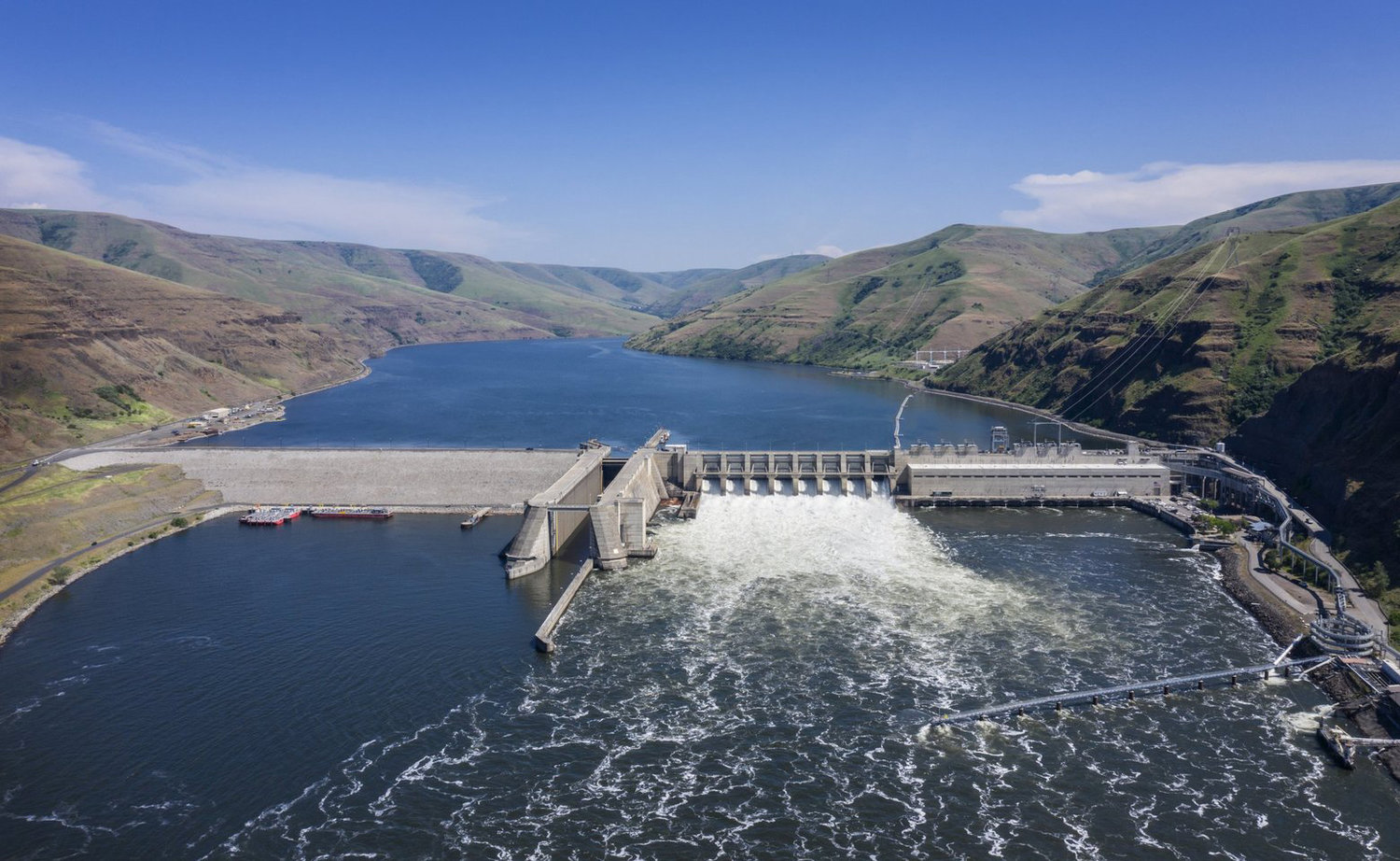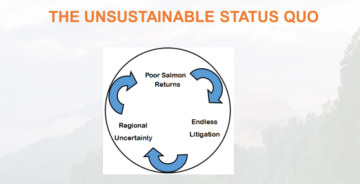
PNW Battle Over Salmon and Dams Intensifies as Biden Administration Moves Toward Breaching
By Sarah Clendenon • December 17, 2023The White House has announced that an agreement has been reached with Oregon, Washington, and four Pacific Northwest Native American Tribes regarding the Lower Snake River dams of the Columbia River Basin.
The Biden Administration calls the agreement a partnership and says the plans and goals are to “restore wild salmon, expand clean energy production, increase resilience, and provide energy stability” for the region.
The Tribes involved in the agreement include the Confederated Tribes and Bands of the Yakima Nation, the Confederated Tribes of the Umatilla Indian Reservation, the Confederated Tribes of the Warm Springs Reservation of Oregon, and the Nez Perce Tribe.
The four affected dams are between Kennewick, WA and Lewiston, ID. These include Ice Harbor, Lower Monumental, Little Goose, and Lower Granite.
This fact sheet published by the White House explains,
“Under President Biden’s leadership, the Federal government is charting a new path forward, in partnership with States and Tribal Nations in the region, for the restoration of wild salmon and other native fish in the Columbia River Basin while safeguarding and strengthening sustainable energy and water resources. The agreement enables an unprecedented 10-year break from decades-long litigation against the Federal government’s operation of dams in the Pacific Northwest.”
AdvertisementIt details the four commitments by the Biden Administration in the agreement:
New Funding for Fish and Wildlife: The Bonneville Power Administration, a federal power marketing administration under the Department of Energy, will invest $300 million over 10 years to restore native fish and their habitats throughout the Columbia River Basin, with added measures to increase the autonomy of States and Tribes to use these funds. Of this $300 million, $100 million would be provided to the four Lower River Treaty Tribes, Washington, and Oregon to use for fish restoration projects, and $200 million would be provided for hatchery modernization, upgrades, and maintenance. The funding is supplemented by additional investments from the Department of the Interior, the Department of Transportation, the U.S. Army Corps of Engineers, the National Oceanic and Atmospheric Administration, and the Environmental Protection Agency.
Tribally Sponsored Clean Energy: The Department of Energy is committing to support the development of at least one to three gigawatts of Tribally sponsored clean energy projects to build energy infrastructure that, if Congress authorizes breach of the Lower Snake River Dams, could help to replace the power generated by those dams. These resources provide the region options should Congress choose to consider dam breach while still meeting clean energy, energy reliability, and other resilience imperatives. The Administration, however, is not making a judgment on whether to breach the dams, nor does it have the authority to do so; that authority resides with Congress.
AdvertisementIncreased Flexibility: The Administration is committing to adjustments to the operations of the Federal hydrosystem to deliver a net-benefit for some fish, while maintaining grid reliability and upholding health and safety requirements. These adjustments will also increase flexibility to deliver power during the summer when it is most needed. Importantly, the agreement provides 10 years of predictable operations for the region.
Studies of Dam Services: The Administration will undertake or help fund studies of how the transportation, irrigation, and recreation services provided by the four Lower Snake River dams could be replaced, to help inform Congress should it consider authorizing dam breach in the future.
A group known as Earthjustice, which is self-described as “the premier nonprofit public interest environmental law organization,” is referenced in this Oregon Capital Chronicle article with a paraphrased statement saying,
“…the agreement explicitly calls for lower Snake River dams to be replaced and breached within two fish generations, or about eight years, to rebuild salmon populations. The group added that while the federal commitments don’t include a decision to breach the dams, they do include a commitment to begin to replace the hydropower and services they provide and to work in partnership on other next steps.”
Washington Governor Jay Inslee’s office posted information and support for the agreement, which they described as,
“…actions that address the urgency of the salmon, climate, energy, and Tribal justice crises facing the Columbia River Basin. …the Columbia Basin Restoration Initiative (CBRI).
….[the] announcement marks a renewed obligation to restoring salmon to healthy and abundant levels, while addressing the services provided by the Federal Columbia River Power System and creating a roadmap for the region to meet growing electricity demand with new, clean energy resources.”
Oregon Governor Tina Kotek is also quoted in the same Oregon Capital Chronicle article saying,
“The Pacific Northwest’s iconic salmon and steelhead are essential to our ecological and economic wealth, and a sacred part of tribal ceremonial, spiritual, and subsistence practices since time immemorial,” Kotek said. “The Columbia River treaty reserved tribes exemplify steadfast leadership in salmon restoration and stewardship, forging a strong partnership with our states in a shared commitment to comanaging this precious natural resource for generations to come.”
Idaho Congressman Mike Simpson has been working on this issue for several years. He has a plan he calls the Columbia Basin Initiative. In the explanation of the concept, he shows a small chart which describes the handling of this issue in the recent past as “the unsustainable status quo.”
Simpson’s concept is primarily an explanation of what would need to happen regarding energy, tourism, agriculture, the remaining dams, the watershed, farmers, irrigators, communities, and more if the four Lower Snake River dams are indeed breached as part of an agreement to protect the salmon and steelhead populations. You can find the slides of the presentation here.
Other Idaho political leaders are not pleased, however, with the recent Biden Administration agreement. In a recent press release, US Senator for Idaho Jim Risch said,
“It occurred behind closed doors, between two parties who wanted the same end result—to tear out our dams, and it completely excluded Idahoans who rely on the River System for its energy, transportation, agriculture, and recreation benefits. I will continue to fight any breaching efforts, and, at every turn, I will reject the Biden administration’s efforts to usurp Congressional authority.”
Idaho Governor Brad Little and Idaho Lieutenant Governor Scott Bedke sent out a joint opinion statement on the matter, saying,
“Sustaining healthy salmon and steelhead populations is important. But make no mistake, that is not what this deal does.
The deal that was released to the parties with only weeks to examine is an aspirational document that spends Pacific Northwest ratepayer money with little to no accountability for outcomes in fish populations or energy production. Perhaps what’s worse, the deal contemplates eliminating thousands of megawatts of clean energy while the region is facing an 8,000-megawatt energy deficit in the next decade.”
Feature photo is an image of the Lower Granite Dam on the Snake River. Courtesy of Steve Ringman of the Seattle Times, published on The Chronicle, chronline.com
Tags: Biden Administration, Brad Little, Columbia Basin Initiative, Columbia River, Dam Breaching, Dams, Hydroelectric power, Idaho, Jay Inslee, Jim Risch, Mike Simpson, Native American Tribes, Nez Perce, Oregon, Salmon, Scott Bedke, Snake River, Steelhead, Tina Kotek, Washington, Water
17 thoughts on “PNW Battle Over Salmon and Dams Intensifies as Biden Administration Moves Toward Breaching”
Leave a Reply


















Marxism 101. Cut off food and water supplies, while pretending to do something for a good cause.
When Salmon migrate to the ocean to start with I’m sure a few get shewed up in the generators and maybe going through the spill way. probably not the same as dropping off a water fall. I would like to see the stats on the outbound side of the Salmon run. When the Salmon decide to return for spawning they go right up the fish ladder as designed or just like the water falls that were in the river before the dams. Some years the water flow is extreme and others not so much. So what part of removing the dams is the answer to completely fix the problem.
Chuck, you’ve posed a good question. According to NOAA Fisheries, for the juvenile salmon migrating from Idaho to the Pacific Ocean, a tad more than 50% die within the hydro system.
Thereafter, a survey of literature by Schaller et al., suggests that 70% of those survivors eventually perish from the “delayed” effects of hydro system passage.
Taken together, this means that only 1 of 8 juveniles leaving Idaho survives the hydro system unscathed.
Get ready to be told next that you will be moved to a 15 minute city far away from the rural area where you currently live.
Norway has both a thriving fish industry and a huge hydro-electricity industry. Norway installs fish ladders on its hydro-electric dams to achieve both. Norway makes it very expensive to buy angler licenses particularly for foreigners. Well regulated fisheries and commercial fishing fleets providing fish to the general public are prioritized over rich sportsmen. The availability of cold-water fatty fish, such as salmon, mackerel, tuna, herring, and sardines, containing high amounts of LC omega-3s are a health issue. There is no way to provide as much green electricity as to utilize existing hydro-electric facilities. The best thing FDR did was to build out a system of hydro-electric plants which have paid for themselves many times over. Who would guess that modern Democrats would prioritize sports fishermen over cheap, clean electrical power.
Idaho rejects the idea of breaching the true clean energy dams. Idaho rejects Fed dollars with strings attached to build power plants that will likely double our family’s electric bills, and lower our standard of living. Idaho rejects giving up our business and income that our standard of living depends on, by removing or reducing our reservoirs and killing the tourism and business that families lives depend on. Idaho rejects any attempt to destroy of livelihoods and standard of living, Keep Idaho Idaho.
Measures such as this one destroyed the California central valley farming community in an effort to save the smelt. Disasterous results all around.
If the native population wants more fish then tell them to quit taking fish out of the river system and close commercial fishing until the numbers rise. Don’t destroy the northwest economy by taking out clean energy that is needed!
Recalling/Replacing Representative Mike Simpson of Idaho, with an actual conservative, would be a good place to start.
Amen
SOMETHING IS FISHY HERE. I’m sure you’ve heard the term, “we are from the Government, and we’re here to help “. Anything the Government touches winds up a disaster. Case in point. There was a legal whorehouse in Nevada years ago that was taken over by the IRS for tax evasion. They were going to run it and keep the profits for the taxes owed. They went broke and had to close. Now if you can’t make money selling selling P- – -y and booze, that’s some bad management. This is a true story. I remember when it happened. I think it was the Mustang Ranch but not sure.
Let me think here. Clean inexpensive renewable energy or the tribes being able to net more salmon and billions of extortion dollars. I’ll take choice number one. It’s just another law suit to extort the tax payers money. As long as the right palms are being greased none of these state, federal or tribal lawyers/politicians give a dam(s) about fish…
Until we view our politicians, government employed and the military as the only enemy on the planet that has destroyed and bankrupted this republic. Our ignorance and the dumbed down tv watchers ruined us.